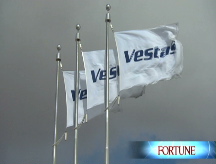Obama budget boosts green spending
Uses proposed cap on greenhouse gases to pay for more clean energy projects, middle class tax cuts.
NEW YORK (CNNMoney.com) -- President Obama promised more money for conservation and renewable energy in his budget outline Wednesday, paid for in part by a mandatory cap on greenhouse gases.
The programs, originally laid out in the stimulus bill, include an effort to double the production of renewable energy in three years, primarily through tax breaks and loan guarantees for the industry.
The budget summary also increases funding for energy conservation in government buildings and private homes. It provides more money for cleaner coal-fired power plants, and to transform the country's aging electric grid.
"Because our future depends on our ability to break free from oil that's controlled by foreign dictators, we need to make clean, renewable energy into a profitable kind of energy," Obama said at a news conference Wednesday. "That's why we'll be working with Congress on legislation that places a market-based cap on carbon pollution and drives the production of more renewable energy."
The budget outline didn't detail exactly how much more money these programs would receive. That will presumably come when thee president unveils his final budget request in April.
The outline did project an extra $2 billion in revenues by 2011 from eliminating certain oil company tax breaks. It also included a revenue increase of over a $1 billion for reinstating a requirement that corporations help fund the Environmental Protection Agency's Superfund program, which cleans up toxic industrial sites.
The president plans on using revenues generated from a cap-and-trade program - where companies pay to emit carbon dioxide - to fund "investments in clean energy" to the tune of $15 billion a year. He also proposes using another $64 billion a year of cap-and-trade revenues to make tax cuts for the middle class permanent.
Spending most of the money generated from a cap-and-trade law on tax breaks may be a good way of wining Republican support for the bill. Some Republicans have indicated they'd support such a move.
But including revenue from a program that has yet to pass Congress may be a risky bet for the administration. A cap-and-trade bill failed in the Senate last year, and one of the first cap-and-trade measures to come before Congress - the Kyoto Treaty in 1997 - failed in the Senate by a vote of 95 to 0.
Supporters of a cap-and-trade policy are hoping that a shift in the public's perception of global warming since 1997 and Democratic gains in Congress in 2008 will make it more likely for such a bill to pass.
In a cap-and-trade program, companies must initially buy permits from the government to emit carbon dioxide, the main greenhouse gas. Then, the number of permits are reduced each year. Companies trade these permits among themselves, which are expected to get more expensive as the number of them decreases. Companies can either pay to install cleaner equipment, or buy permits from other companies that have them.
Projections vary as to how much revenue a cap-and-trade bill would generate.
According to tables released by the White House Wednesday, the cap-and-trade law is expected to generate $79 billion a year in 2012.
An analysis of last year's failed cap-and-trade bill by the Congressional Budget Office projected revenues of $145 billion a year in 2012, rising to nearly $200 billion a year by 2018.
A separate analysis of last year's bill by the Energy Information Agency said enacting the legislation would raise the price of gasoline by about 41 cents a gallon and the price of electricity by about 11% by 2030.
For that, EIA projected carbon dioxide would be reduced by about 30% from 2006 levels.
The administration's current budget proposal calls for a 14% reduction in carbon dioxide from 2005 levels by 2020 and an 83% reduction by 2050.
It's not clear if the administrations' $79 billion revenue projections are anticipating a weaker cap-and-trade bill than last year's effort, or if the budget outline is an incomplete list of expected revenue.
Environmentalists have said that including a cap-and-trade measure in the budget outline signals just how serious the administration is in getting a law passed.
They also argue that raising the price of carbon dioxide is the only way the nation will shift from fossil fuels to renewable energy.
Detractors, including some Republicans in Congress, say a cap-and-trade law will actually result in less government revenue, as it will drive U.S. business overseas.
Congress is now awaiting a detailed budget proposal from Obama, but it's far from clear if the projected funding from a cap-and-trade bill will remain in the budget once Congress begins reshaping it. ![]()



